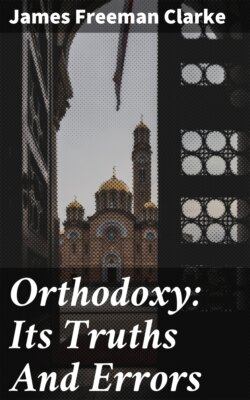Читать книгу Orthodoxy: Its Truths And Errors - James Freeman Clarke - Страница 21
На сайте Литреса книга снята с продажи.
§ 4. Argument of the Supernaturalist from successive Geologic Creations.
ОглавлениеTable of Contents
The supernaturalist says, God comes to us in both ways—through nature; that is, through the order of things already established; and also by new creative impulses, coming in, from time to time, from above. He [pg 046] contends that such a new creative impulse came into the world through Jesus Christ, adding a new substance and new forms to those already existing—a new life not before in the world, proceeding according to new laws. This new creation, as the Scriptures themselves term it, is Christianity. This is also said to be in analogy with the course of events. For, if there has been a series of creations before, bringing animals into the world, and higher forms of physical life—if these have been created by new supernatural impulses coming in at intervals of hundreds of thousands of years—why deny that another impulse may have come in four thousand years, or forty thousand years, after man was created, to add a new form of spiritual life to society?
In the world, as it was at first, there was not a living plant or animal; after thousands of years, or millions of years, there came into the broad seas of the lower Silurian epoch, some of the lowest kinds of animals and seaweeds, a few trilobites and mollusks, but no plants save fucoids. Next came, after a long time, a few cartilaginous fishes and corals. A long time passed—thousands of years rolled by: then came real fishes and land plants in what is called the Devonian period, or the old red sandstone. After a great while came the period to which belongs all the coal formation; and in that carboniferous epoch first appears a whole vegetable world of trees and plants, to the number of nine hundred and thirty-four species. Some insects arrived at this time, as beetles, crickets, and cockroaches, which are, therefore, much more venerable than man. More thousands of years go by: then the earth receives a new creation in the form of gigantic frogs, enormous reptiles, and strange fishes. But as yet no mammal has come—not a bird nor a quadruped has been seen on the earth. Then, after another long period, these appear, in what is called the tertiary period; until, at last, some remains of man are found, in the diluvium, or gravel. Geology thus, once thought to be atheistic, gives its testimony [pg 047] to a long series of supernatural facts; that is, to the successive creation, after long intervals, of entirely new genera and species of vegetables and animals. As you turn these great stone leaves of that majestic manuscript roll written by God's hand, which we call the earth, you and he has been writing new things on each page, new facts and laws, not on any former leaf. New types of life, not prepared for by any previous one—by no slow evolution, but by a sudden step—break in. On the previous rocky page is to be found not one of their species, genus, order, or even class, to point back to any possible progenitor. So that the globe itself says, from these eternal monuments of rock, “Behold the history of supernatural events written on me.” Each creation is higher than the last: finally man is created. But still from above, from outside the world, the creative life is ready to be poured in. Only the next creation is to be moral and spiritual, not physical. No new physical forms are now added, but a new moral life is poured into man, making him a new creation of God. “For if any man is in Christ, he is a new creature.” The analogy was so striking, that the apostles noticed it, and constantly speak of Christ as the medium of a new creation.
